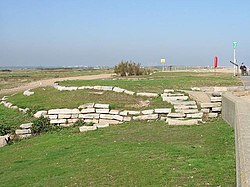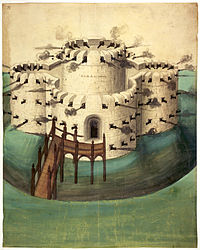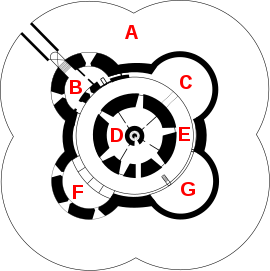Difference between revisions of "Sandown Castle, Kent"
(Created page with "{{Infobox castle |name=Sandown Castle |county=Kent |picture=The site of Sandown Castle - geograph.org.uk - 585517.jpg |picture caption= |village=Sandown |os...") |
(No difference)
|
Latest revision as of 20:23, 6 April 2021
| Sandown Castle | |
|
Kent | |
|---|---|

| |
| Type: | Device fort |
| Location | |
| Grid reference: | TR375543 |
| Location: | 51°14’18"N, 1°24’8"E |
| Village: | Sandown |
| History | |
| Built 1539 - 1540 | |
| Information | |
| Condition: | Limited ruins remain |
Sandown Castle was an artillery fort constructed by King Henry VIII in Sandown, Kent, between 1539 and 1540. It formed part of the King's programme to protect against invasion from France and the Holy Roman Empire, which had allied against him after King Henry's breach with the Papacy. The new forts were built in accordance with a royal instruction (a "device"), hence the term by which they are now known, the "device forts".
The fort at Sandown defended the strategically important Downs anchorage off the Kentish coast. The fort was destroyed in the 19th century: the remaining ruins are a Scheduled Monument.[1]
Comprising a keep and four circular bastions, the moated stone castle covered just over half and acre and had 39 firing positions on the upper levels for artillery, with 31 gunloops in the basement for handguns. It cost the Crown a total of £27,092 to build the three castles of Sandown, Walmer and Deal, which lay adjacent to one another along the coast and were connected by earthwork defences.
The original invasion threat passed. However during the Second English Civil War of 1648–49, Sandown was seized by Royalist insurgents and was only retaken by Parliamentary forces after several months' fighting.
By the 19th century, the castle was suffering badly from the effects of coastal erosion but remained in military use until 1863. The War Office then demolished the upper levels with explosives, carrying out a second wave of demolition work in 1882 and destroying most of the surviving stonework in 1893. The remains of Sandown were purchased by the town of Deal for £35 to form part of the local sea defences. The remaining masonry was encased in concrete in the late 1980s to form a sea wall but remains vulnerable to further erosion by the sea.
Contents
History
16th century
The breach with Rome took place in 1533, and in 1538 France and the Holy Roman Empire declared an alliance against Henry in 1538, with the Pope encouraging an invasion of England.[2][3] In 1539, King Henry issued his device giving instructions for the defence of the realm in time of invasion and work began on new forts along the south coast.[4][5]
Sandown and the adjacent castles of Deal and Walmer were constructed to protect the Downs off eastern Kent, an important anchorage formed by the Goodwin Sands that gave access to Deal Beach, on which enemy soldiers could easily be landed.[6][4] The stone castles were supported by a line of four earthwork forts, known as the Great Turf, the Little Turf Bulwark, the Great White Bulwark of Clay and the Walmer Bulwark, and a two and a half mile long defensive ditch and bank.[4] Collectively the castles became known as the "castles of the Downs" and cost the Crown a total of £27,092.
The castle was built between April 1539 and the autumn of 1540, by a team including Richard Benese as the surveyor, William Clement as the master carpenter, and Christopher Dickenson as the master mason.[4][7] It was nearly identical to its sister castle at Walmer, with a tall keep, 83 feet across, at the centre, and flanked by four rounded bastions, also called lunettes, and a moat, which was surrounded in turn by a curtain wall.[4][8][9] Its curved walls were 15 feet thick.[9] In total it was approximately 165 feet by 165 feet across, covering 0.59 acres.[10]
Sandown had three tiers of artillery – the heaviest and longest range weapons occupying the upper levels – with a total of 39 firing positions, and 31 gunloops in the basement for handguns should close defence be required.[4][9] The embrasures in the walls were all widely splayed to provide the maximum possible space for the guns to operate and traverse, and the interior of the castle was designed with vents to allow the smoke from its guns to escape. It was initially garrisoned by a captain, two lieutenants, two porters, ten gunners and three soldiers, at an annual cost of £174 a year.[11]
17th century
The invasion threat passed, but Sandown continued in military use into the 17th century. A 1616 survey nonetheless reported that a range of repairs were needed, at an estimated total cost of £437, while a 1634 survey noted that work estimated at £1,243 was required.[12] In contrast, an inspection in 1635 showed the castle to be in reasonable structural condition, but antiquated in design.[13] A report produced in 1641 suggested that £8,000 of investment was required in the three castles of the Downs, including £3,000 for additional sea defences.[12]
Sandown Castle did not play a prominent role during the first Civil War between the supporters of King Charles I and Parliament; it was taken by Parliamentary forces at the start of the conflict in 1642.[14] Following the few years of unsteady peace after 1645, the Second Civil War broke out in 1648, this time with Charles' Royalist supporters joined by Scottish allies. The Parliamentary navy was based in the Downs, protected by Sandown and the other Henrician castles, but by May a Royalist insurrection was underway across Kent.[15][16]
Vice-Admiral William Batten had been forced by Parliamentary officials to resign from his post as Commander of the Fleet the previous year, and he now encouraged the fleet to join the Royalist faction.[17][15] Sir Henry Palmer, a former sailor, accompanied by other members of the Kentish gentry, also called on the fleet to revolt, taking advantage of the many fellow Kentish men in the crews.[18] Sandown Castle declared for the King, followed shortly afterwards by the garrisons at Deal and Walmer as well.[19] With both the coastal fortresses and the navy now under Royalist control, Parliament feared that foreign forces might be landed along the coast or aid sent to the Scots.[18]
Parliament defeated the wider insurgency at the Battle of Maidstone at the start of June, and then sent a force under the command of Colonel Nathaniel Rich to deal with Sandown and the other castles along the Downs.[18][15] Walmer Castle was the first to be besieged and surrendered on 12 July.[15] An earthwork fort was then built between Sandown and Deal, which may have been defended by around 150 men each.[15] Deal was attacked in late July, and in August artillery assaults began on Sandown as well.[15] The Royalists mounted an attack from the fleet on 10 August, with a second attack following on 15 August, involving a landing of 750 men supported by 50 soldiers from Sandown. Neither operation was successful and Sandown finally surrendered on 5 September, a few weeks after the surrender of Deal.[15][18]
In 1649, Parliament ordered that supplies of ammunition and powder be sent to Sandown and the other castles of the Downs.[20] Fresh earthworks were erected during the Interregnum between Sandown and Deal to address with the threat of Dutch attack.[20] The garrison at Sandown remained substantial during the period, with a governor and 21 soldiers, but when Charles II was restored to the throne in 1660 he reduced the numbers again to a captain and 18 men.[20]
The former Parliamentarian, Colonel John Hutchinson, was infamously detained by the Crown at Sandown in 1664; his wife, Lucy, who subsequently widely publicised his case, described the castle as ruinous and his imprisonment there as inhumane.[21] After several months Hutchinson died in the castle, his doctor blaming his physical decline on the conditions in which he had been kept.[21]
In the Glorious Revolution of 1688 against Charles' brother, King James II, the townsfolk of Deal seized Sandown Castle on behalf of William III, the Prince of Orange.[22]
18th–21st centuries
In 1785, the sea broke through the outer walls of the castle, and coastal erosion continued over the next few years.[23] The castle was initially described as being "barely habitable", but by 1793 it was considered "unfit for habitation."[23] It was repaired and garrisoned again during the French Revolutionary Wars, with two new artillery batteries being constructed to the north of the castle.[23][24]
Early in the 19th century the castle was used as by the early coastguard for the suppression of local smuggling.[23][25]
Coastal erosion continued during the 19th century. As a consequence, the War Office sold off the reusable materials of the fortification for £564 in 1863 and demolished the upper parts of the castle, leaving a level platform across the lower parts of the keep and the bastions.[23][26] Part of the stone was purchased by the Earl of Granville and used in his building work at Walmer Castle, while other masonry was reused in the construction of Deal Pier.
The sea continued to erode the remaining stonework and destroyed one of the adjacent artillery batteries – the other was converted for use by the coastguard.[23] In 1882 the Royal Engineers used explosives to remove around 600 tons of masonry from the castle for use in the construction of an officer's house at Dover Castle, causing further damage.
In 1883 architectural historian Hayter Lewis complained to the British Archaeological Association that more needed to be done to protect the ruins, contrasting their poor treatment with that of the other castles along the coast.[27] Despite this, concerns continued to be raised about the safety of the ruins facing along the sea, and in 1894 the Royal Engineers blew up the bastions and the keep on the seaward side using guncotton.[28] The town of Deal then bought the remains from the government for £35 for use as part of their local sea defences.[21] Coastal erosion continued and between 1988 and 1989 the remains were encased in concrete to form a sea wall, although they remain vulnerable to further coastal erosion.
The remains of the castle are protected by law as a scheduled monument.[29]
Outside links
| ("Wikimedia Commons" has material about Sandown Castle, Kent) |
References
- ↑ National Heritage List 1005147: Sandown Castle (Scheduled ancient monument entry)
- ↑ Morley 1976, p. 7
- ↑ Hale 1983, pp. 63–64
- ↑ 4.0 4.1 4.2 4.3 4.4 4.5 Harrington 2007, p. 8-21
- ↑ Walton 2010, p. 70
- ↑ King 1991, p. 178
- ↑ "A Colored bird's Eye View of "A Castle for the Downes"; Probably an Early Design for Walmer and Sundown Castles". British Library. http://www.bl.uk/onlinegallery/onlineex/unvbrit/a/001cotaugi00001u00021000.html.
- ↑ Rutton 1898, p. 26
- ↑ 9.0 9.1 9.2 Saunders 1989, p. 38
- ↑ Rutton 1898, p. 26
- ↑ Elvin 1890, p. 162
- ↑ 12.0 12.1 Elvin 1890, pp. 172–173, 177-178
- ↑ Bull 2008, pp. 82–83
- ↑ Elvin 1890, p. 183
- ↑ 15.0 15.1 15.2 15.3 15.4 15.5 15.6 Harrington 2007, p. 50
- ↑ Kennedy 1962, pp. 251–252
- ↑ Kennedy 1962, pp. 248–250
- ↑ 18.0 18.1 18.2 18.3 Ashton 1994, p. 439-442
- ↑ Kennedy 1962, pp. 251–252
- ↑ 20.0 20.1 20.2 Elvin 1890, p. 210-213
- ↑ 21.0 21.1 21.2 Mackenzie 1896, p. 40
- ↑ Elvin 1890, p. 224
- ↑ 23.0 23.1 23.2 23.3 23.4 23.5 Elvin 1890, p. 226
- ↑ Elvin 1894, p. 138
- ↑ Elvin 1894, p. 188
- ↑ Lewis 1884, p. 177
- ↑ Lewis 1884, pp. 177–178
- ↑ Mackenzie 1896, pp. 38–39
- ↑ National Heritage List 1005147: Sandown Castle (Scheduled ancient monument entry)
Bibliography
- Anonymous (1883). The Annual Register: A Review of Public Events at Home and Abroad, for the Year 1882, Part II. London, UK: Rivingtons. OCLC 874176803.
- Ashton, Robert (1994). Counter-revolution: The Second Civil War and Its Origins, 1646–8. Avon, UK: The Bath Press. ISBN 9780300061147.
- Biddle, Martin; Hiller, Jonathon; Scott, Ian; Streeten, Anthony (2001). Henry VIII's Coastal Artillery Fort at Camber Castle, Rye, East Sussex: An Archaeological Structural and Historical Investigation. Oxford, UK: Oxbow Books. ISBN 0904220230.
- Bull, Stephen (2008). 'The Furie of the Ordnance': Artillery in the English Civil Wars. Woodbridge, UK: Boydell Press. ISBN 9781843834038.
- Elvin, Charles R. S. (1890). Records of Walmer, Together with "The Three Castles that Keep the Downs". London, UK: Henry Gray. OCLC 4866519. https://archive.org/details/recordsofwalmert00elvi.
- Elvin, Charles R. S. (1894). The History of Walmer and Walmer Castle. Canterbury, UK: Cross and Jackman. OCLC 23374336. https://archive.org/details/historywalmeran00elvigoog.
- Hale, John R. (1983). Renaissance War Studies. London, UK: Hambledon Press. ISBN 0907628176.
- Harrington, Peter (2007). The Castles of Henry VIII. Oxford, UK: Osprey Publishing. ISBN 9781472803801.
- Kennedy, D. E. (1962). "The English Naval Revolt of 1648". The English Historical Review 77 (303): 247–256. doi:10.1093/ehr/lxxvii.ccciii.247.
- King, D. J. Cathcart (1991). The Castle in England and Wales: An Interpretative History. London, UK: Routledge Press. ISBN 9780415003506.
- Lewis, T. Hayter (1884). "The Castles of Sandown and Sandgate". Journal of the British Archaeological Association 40 (2): 173–178. doi:10.1080/00681288.1884.11887698.
- Mackenzie, James D. (1896). The Castles of England: Their Story and Structure, Volume II. New York, US: Macmillan. OCLC 504892038. https://archive.org/details/castlesenglandt00mackgoog.
- Morley, B. M. (1976). Henry VIII and the Development of Coastal Defence. London, UK: Her Majesty's Stationery Office. ISBN 0116707771.
- Rutton, W. L. (1898). Henry VIII's Castles at Sandown, Deal, Walmer, Sandgate, and Camber. 23. pp. 24–30.
- Saunders, Andrew (1989). Fortress Britain: Artillery Fortifications in the British Isles and Ireland. Liphook, UK: Beaufort. ISBN 1855120003.
- Thompson, M. W. (1987). The Decline of the Castle. Cambridge, UK: Cambridge University Press. ISBN 1854226088.
- Walton, Steven A. (2010). "State Building Through Building for the State: Foreign and Domestic Expertise in Tudor Fortification". Osiris 25 (1): 66–84. doi:10.1086/657263.
| Henry VIII's Device Forts on the south coast |
|---|
|
Kent: Sandown Castle • Deal Castle • Walmer Castle • Sandgate Castle • Sussex: Camber Castle • Hampshire: Southsea Castle • Hurst Castle • Calshot Castle • Cowes Castle • Yarmouth Castle • Netley Castle • St Andrew's Castle • Dorset: Portland Castle • Sandsfoot Castle • Cornwall: Pendennis Castle • St Mawes Castle |



